#adela misericorde
Explore tagged Tumblr posts
Text
Adela's Tarot
Finally back to Chapter 15, and while I don't have any bit stunning revelations about Catherine's wake I did some research into Adela's tarot reading. First, to get a better idea of what the cards might mean, and second to have a better look at the deck Adela's using.
I don't know tarot, so I might be a bit off about the symbolism of the cards, whether 15th or 20th century. If I'm wrong, feel free to correct me or add to what I've said!
First, what deck is Adela using?




Looking up tarot decks from that era, these all seem to be from the Cary-Yale Visconti Tarot deck




This set dates back to at least the 1460s, and could be from the 1440s, making it one of the oldest existing sets. While it's incomplete, it has some unusual features you can see here: First, it has six face cards rather than four. Along with King, Queen, Knight and Knave there's also the Horsewoman and Damsel. Here, the Damsel of Swords image is used as the Queen of Swords. Second, like Minchiate decks, it includes Faith, Charity, and Hope as trumps. Here, the virtue of Charity is used for the High Priestess: the Cary-Yale deck is missing the High Priestess/Papesse. It could be that like minchiate it doesn't have that trump, or because it's been lost. It looks like modern reproductions don't try to recreate the High Priestess as they do for, say The Devil, but either don't have one or just rename "Charity" to "The High Priestess".
This is a really cool deck, and I'll be comparing this tarot to the modern Rider-Waite cards as we go through the reading. One thing is clear, if Adela has a deck like this her mum must have been loaded.
So let's start with the reading! First up, Charity (the nun, not the card) was just finishing with a reading. Her present card was Three of Cups, inverted


Adela reads it as "A lack of time to socialize", as Charity says she's too tired to stay up and is going to leave partway through the wake. I'm not sure how much more I can read into it. I am seeing reversed 3 of cups being read as warning of a betrayal or spy, but who knows if that's coming up. Hedwig's certainly a "spy" of sorts, but it's hard to say if that really affects Charity.
Hedwig's Past: The Seven of Cups, Inverted


"It represents illusions, imagination, creativity. But as you can see, it is inverted! ...You spent a lot of time with nobody but yourself. Nothing but your own imagination. Clinging to this past will not help you."
Wishful thinking is one reading, but the Seven of Cups can also represent choice or temptation, as well as self delusion. The Rider-Waite one has the cups offering various visions. Inverted, it can refer to a loss of old goals and closing off choices, or it can reflect a moment of clarity. Old illusions have been cast off, false paths are closed off and you can better see the right choice. I can see both applying to Hedwig: as Adela suggests, leaving her cell means giving up her lifelong vocation as anchoress. But more recently, Hedwig had spent weeks in a depressive fugue, unable to progress on the investigation, and in the village had a vision which she saw as a warning to get back on track. That could fit with the reversed Seven of Cups.
Hedwig's Present: The World, Inverted


"In this reversed position, The World represents your inner torment. You are secluded. You are lonely. You are withdrawn... Because! Something has been troubling you, yes? Something you need to get to the bottom of. Something that has been preoccupying you ever since you left your cell. Am I correct? You were alone in your cell for many years and now you have been set adrift."
I'm also seeing the world inverted as a need for closure, incompleteness, and frustrated goals as Adela says. Waite says The World can represent flight, while an inverted World can be inertia and stagnation.
One thing I find interesting with both the Visconti and Rider-Waite World cards is their relation to Hedwig's vision. Hedwig's first reaction to her vision is that it's a warning about her lack of progress, as the inverted World represents stagnation and incomplete goals. Rider-Waite's World shows a flying woman surrounded by the four biblical Living Creatures, as Ezekiel and John of Patmos saw in their visions. Pamela Smith's illustration quotes depictions of Christ surrounded by the four creatures representing the four evangelists, Matthew being the man. Obviously this is totally outside the text as Waite and Smith won't be born for 400 years, but it's interesting that Hedwig had left the Book of Matthew incomplete. Similarly, she's failed to finish reading Medea, and will never have the full experience of discussing it with Catherine. The play ends with Medea flying away in a chariot.
The Cary-Yale Visconti World card looks very similar to Hedwig's vision. She was taken up, seeing the town of Linbarrow and the lake below, and when she landed on the hill she saw God looking down on her, like the figure in the card. I'm not sure if that figure is meant to be a woman (the hat and very high forehead look a bit feminine to me, but I'm not sure), but if so, it could also be Hedwig flying above the town. But the imagery, and Adela's interpretation, match Hedwig's vision very strongly.
Hedwig's Future: The Queen of Swords, Inverted



"A reversed queen of swords in this position means you will continue to have a hard time moving forward into the future. You must make some decisions, Sister Hedwig! This Queen in reverse suggests to me that you must find some strength inside yourself to move beyond your current predicament. Perhaps there is something small you can think of and change."
Adela is, perhaps, softening things to not scare Hedwig. An upright Queen of Swords is rational judgement, mental clarity and maturity. She puts thought into action. To Waite, she knows sorrow, and is perhaps a widow (Katherine?). In the future, she can represent a guide.
Reversed, then, she can mean emotion overpowering reason, spite, and vindictiveness. As a warning against holding grudges and failing to learn from errors, she fits with Hedwig's vision very well (Proverbs 26:11). A reversed Queen of Swords can be an absent mother, which could fit with Catherine, or Mabel's failings as Mother Superior, but I'm not sure how that belongs in the future. Waite sees a reversed Queen of Swords as warning of malice, bigotry, deceit, and specifically of a woman bearing ill-will towards Hedwig.
Much to think about, but there's more: while the text says Queen of Swords, if we go by the image, just for fun, the Damsel of Swords is equivalent in rank to Page of Swords. Waite suggests a reversed Page of Swords can mean evil coming through spying, or from an authority figure. It could mean some unforeseen events are coming, that you will be unprepared, possibly sickness is in the future. This could definitely come up too.
A paranoid, Pepe-Silvia overreading of this could ask why the Damsel is being mistaken for a Queen. Two similar swords, two similar women. Could this be Urim and Thummim? Could the women be Catherine and Katherine, or Catherine and Hedwig? Could Xeecee have just decided they liked how the Damsel card looked?
"Is this real?": The High Priestess/Charity



"Well... To be honest, I think this card is imbued with such mystery that your answer is... unclear."
"Isn't it funny how every card is imbued with enough mystery to mean whatever you like?"
"The cards have malleable meanings, it is true. That makes them better at their intended purpose, not worse."
Adela, of course, doesn't have the benefit of knowing Hedwig's question. The High Priestess is a symbol of intuition, esoteric knowledge, the subconscious mind. To Waite, she is "the highest and holiest of the Greater Arcana", the future as yet unknown, and mystery. He's a bit heteronormative in saying that to a female querent she must represent the querent herself rather than a love interest, but here I think that fits.
I think the answer is that the tarot will help Hedwig understand the mystery. Is it real? Maybe it is. Maybe it's just a guide for things Hedwig doesn't realise she already knows (as Darcy says of her vision), something that will help her make that intuitive leap to understand how it all fits together.
Now, technically, the card shown is Charity, not the High Priestess. I'm not sure how you might read Charity here ("Hey, Adela's just trying to help you out" maybe?), but when Darcy is helping Hedwig interpret her vision, the name of the track playing is "Caritas". Could be a connection, could be pareidolia.wav.
I included the Morgan-Bergamo Viscont-Sforza Papesse card for historical reasons. It's a depiction of Sister Manfreda, who was elected Pope by a 13th century heretical sect, which believed that in the year 1300 their founder Guglielma of Bohemia would return to earth and found a new church, lead by women. These Guglielmites were charged with heresy and Manfreda was burned at the stake.
As someone who knows little about cartomancy, and less about late medieval Lombard heresies, I'm not sure what to make of that. But I think I've made a decent try at sorting it out.
27 notes
·
View notes
Text

This is going to happen in Volume 2, trust me!
(ref pic under the cut)

17 notes
·
View notes
Text

my small contribution to the misericorde fandom
#misericorde vn#misericorde#made this because of my friend#i would've put flora and adela too but didnt have enough space sadly..........
31 notes
·
View notes
Text
Prelims: Misericorde
Top two results will join the bracket. Hedwig, Darcy and Eustace automatically qualify.










14 notes
·
View notes
Note
Hello! First i wanted to say i love misericorde so much it is sooooo good i love the characters and the music and the story.....so excited for volume 2!!!
My question is, do you have any fun facts you can share about the characters? I always love reading those on character wikis and such....
Thank you! I'm glad you're enjoying it!
Hmm, fun facts...
Margaret and Katherine have a yet-to-be-shared name for their duo
Adela can speak five languages
Angela's knife has seen action. But what kind? Maybe we'll find out, maybe we won't...
Charity and Marta have known each other longer than some of the characters have been alive
Katherine is the most outwardly vain, but Moira is actually *incredibly* particular about her appearance
Eustace loves fishing
Speaking of languages, Angela speaks Italian
Flora tried poetry before her current interest in drawing
Margaret's lute was a gift from Catherine and Moira that required a lot of string-pulling (no pun intended)
38 notes
·
View notes
Text
Misericorde and Fiore
Disclaimer: I have a few years of German longsword training but I'm pretty rusty and I'm not that familiar with Fiore. Images and text from fightlikefiore on wordpress and Wikitenauer. I don't think “the nuns use swords” is a spoiler when there's a nun and a sword on the title screen but getting into the characters might be a bit spoilery.
There's a scene in Misericorde at Catherine's wake where the nuns break open sherry barrels with a sword in her honour.
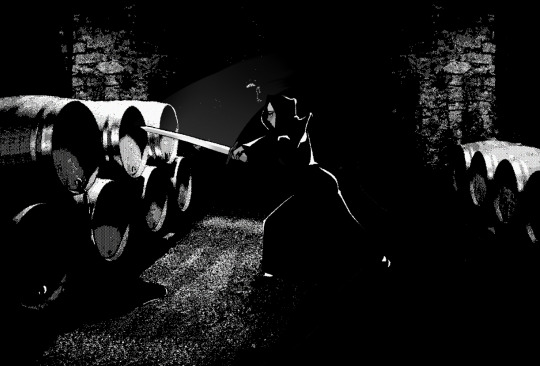
When I saw Adela I thought her stance looked very familiar.
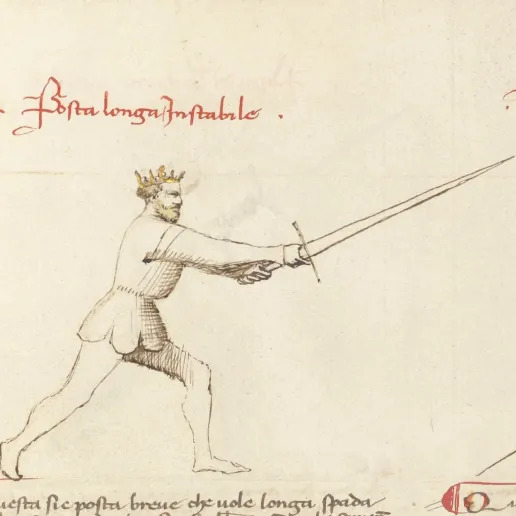
This is from Fior di Battaglia by Fiore dei Liberi, written circa 1404. I'm pretty sure Xeecee used fencing manuals as references for their drawings.
Lets see what each nun's stance might tell us!
Adela: Posta Longa
This is Posta Longa (Long Guard), full of deception. She is feeling the guards of the opponents to decieve them. If she can wound with a thrust, she will do it well. She dodges the blows and can strike back. She can do it more than the other guards who cannot use such deception.
Adela is clearly a skilled swordwoman: she breaks the barrel in one strike. Also, she likes being clever. Look at how she plays chess. She gets mad when Moira beats her just by gaining a material advantage, instead of coming up with a clever strategy. This is very romantic (even if “romantic chess” like tarot readings is a bit anachronistic). Forcing your enemy to break your guard and countering it with a clever, deceptive move is very fitting for her
Katherine: Posta de Donna la Sinistra
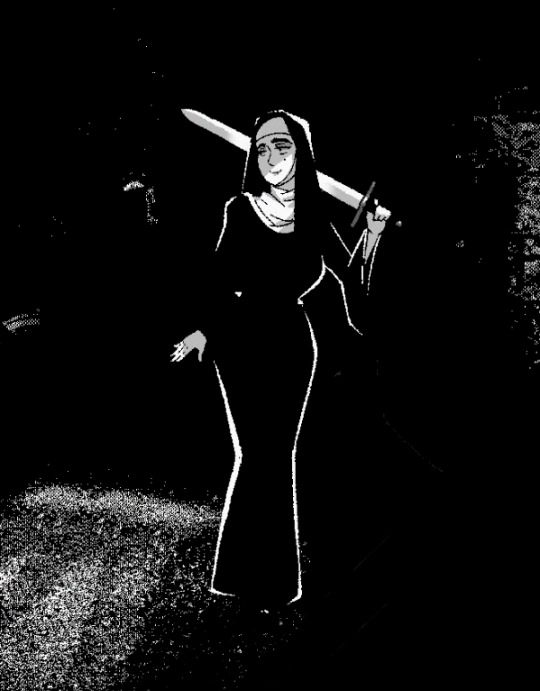

This is the Posta di Donna la Sinestra (Lady’s Guard on the Left) and she is always ready to cover and wound. She makes great blows and breaks the thrusts and beats them to the ground. And enters the narrow play due to her skill in traversing. These plays such a guard knows how to do well.
Of course Katherine uses the Lady's Guard. Xeecee draws it very casually, like she's just posing with a sword looking hot, but if you underestimate Katherine you're making a big mistake.
You could make a pretty powerful strike to the neck from this guard.
Moira: Alber
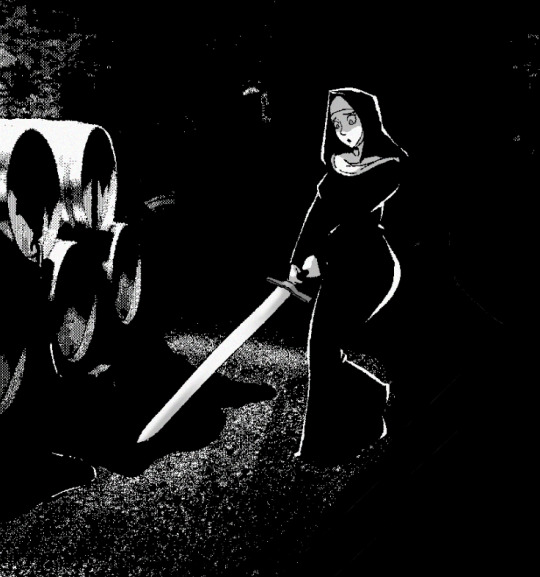
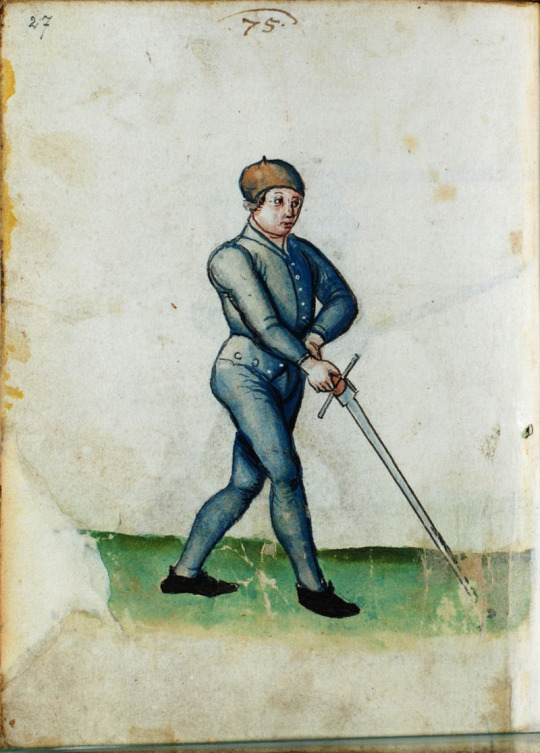
Oh no, Moira doesn't know how to hold a sword, it's too heavy for her, right? Wrong. This is Alber, “The Fool”, which to the untrained looks weak and invites attacks but can easily parry them and strike back.
The equivalent in the Fiore tradition is Posta Tutti Porta di Ferro, the Full Iron Gate Guard. Other German swordmasters call it Eisen Pforte, Iron Gate. That's a much better description of its strength.
If you are beset with four or six impertinent peasants Place in front whichever foot you want and with the gate make a barrier And put the point on the ground / now hear what you should do See to it that they stay all in front of your face And no one comes behind you Now hear what you should do Whatever they strike or thrust against you, weak them with absetzten Strongly upwards from the ground / so you will put them to shame
This is really interesting! Moira isn't as soft as she looks. She's got hidden depths to her, and real iron inside. It's even possible she's putting up a front, and is just luring you in so she can put you to shame.
Eustace: Posta Coda Longa



‘You are cowardly wretches and of this art you know little. Do the deeds that you can only talk of. Come one by one, if you dare, and if you were a hundred I would ruin you all, this guard is so good and strong.’
Eustace would fucking say this.
Also, the description of her seven strikes, left right left right top top thrust, reminds me of sword training. Like the Meyer Squares and that. Eustace is getting in some good practice!
Darcy: Mordhau / Posta de Donna la Soprano

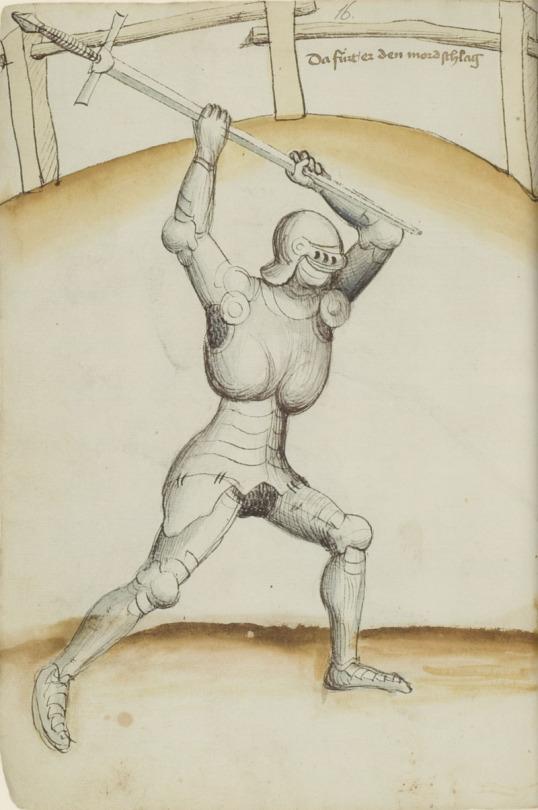
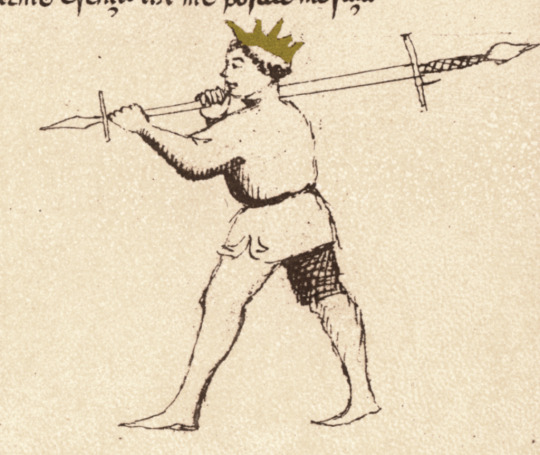
Here he leads with the murder strike
This sword is used as a sword and an axe. And its great force can stop any attack from a lighter weapon. This guard is also called the Posta di Donna la Soprano (High Lady's Guard) who with her skill can fool the other guards, because you think she will attack you with a strike, but instead she will attack with a thrust. All I have to do is raise my arms above my head and I can then quickly launch a thrust at you.
This looks silly, but Darcy's found the right technique for breaking open wine barrels with a sword. Aside from Adela she's the only one to do it in one strike. It's a lot safer if you have proper gloves or gauntlets though. Darcy can seem goofy but she knows what she's doing.
I'll have to see where the story goes, especially with the possible implication that Moira's hiding something, but it's interesting to think about!
94 notes
·
View notes
Text
Chapter 10 of Misericorde (where Hedwig goes to the Misericord) has a lot to say about words, meaning, and non verbal communication.
To start with, there's Darcy's tincture and the lectio divina. Hedwig feels that she needs to read to calm herself, but all she has is Medea so she "reads" the bottle the tincture. She focuses her whole attention on the sight, sound, and feeling of the tiny glass bottle, comparing it to lectio divina, "The sacred act of re-reading and repeating a single line of scripture... Over and over... until it almost feels meaningless. Until the words are just sounds and the letters are just shapes (...) and simply living inside the true meaning of it. Reaching understanding through feeling rather than language."
Then, after Adela and Hedwig dance, and the music winds down, Margaret plays her song, and asks Hedwig what she thinks of it
youtube
Margaret smiles sadly at Hedwig, and the screen goes black. It's just the music and text.
I sometimes wonder if I ever had a single earnest exchange while I was outside of this cell. You and I, as we are here, this is as honest as it can get for me. I am free from reinterpreting whatever flickers across your face as your true intent. Speaking face to face is like reading a book with words that rearrange themselves.
The image returns

Hedwig is confused at the idea of music being "about" anything aside from the lyrics, before realising the song feels sad. Margaret wrote it while it was sad, the notes sound sad, but she can't explain why they're sad or how Hedwig could hear it. Similarly, Margaret once spoke with Catherine about how as a child she loved hymns despite not understanding any of the words. To Catherine, that was proof that God was in the music itself.

A few days later, when Hedwig has a vision and speaks to Darcy about it. Darcy can't explain the vision, but tells Hedwig she must be able to, since God is trying to tell her something and wouldn't show her something she couldn't understand.

So, Hedwig says that only pure verbal communication is "earnest". Or, she can only be earnest that way, as if she sees people's reactions she can't be honest with them. But she also tells Margaret that despite speaking the same language she feels she can barely understand her sisters. She feels the truest and deepest understanding of scripture comes from reading the same line until its semantic meaning is gone and you transcend language, but talking face to face is like a book where the text keeps changing. Expressions have their own meaning and they change too quickly for her to ignore them. Music can communicate meaning, even without words. Things that aren't words can be read, and even words have their own meaning beyond words. And when God speaks, he doesn't always use words.
There is a lot to unpack here, but I'm going to look at it from a metafictional angle. Not so much from the Umineko trust/romance "God would not show you something you couldn't understand" angle, but the medium of the visual novel itself. A visual novel has words, but it also has facial expressions, images, music. These aren't the words but they all have meaning. If you only pay attention to the words, you're going to miss something.
16 notes
·
View notes